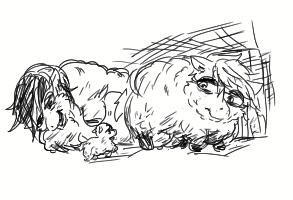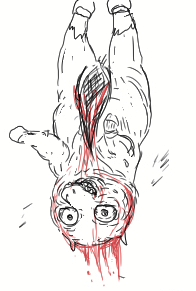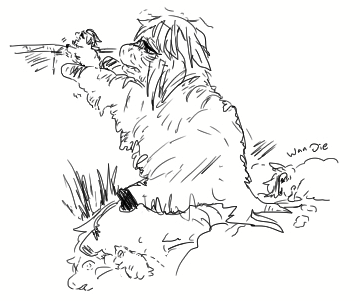Cut to the outside view of a small barn behind a house in the outskirts of a city.
Narrator: “Here we see a small fluffy farm, not many of them left after big fluffy mills and factories drove prices down.”
Now the inside of the farm, you see some pens made of chicken wire, the floor its mostly wood chips and there are steel food dishes and water bottles the kind that isn’t meant to be pretty but durable. Inside each pen are 3 mares of different colors but all the same type: alicorns
“With prices going further down any decent small or medium breeder had to specialize or risk going bankrupt. Here we see ‘The Alicorn Ranch’, the owner specializes in alicorns and nothing else. Here we see one of many pens holding mares waiting for their next breeding cycle. There are 6 pens with 3 mares each for every stallion pen with 4 studs.”
A close-up of another pen, this one for foals. In two different corners you see the only non-alicorns in the pen, two full grown mares one a purple unicorn with a red mane and another a blue earthie with a yellow mane. Both have their legs and body strapped to the walls, a hose going into the mouth for feeding and are sitting on top of a drain hole where the waste falls below. You see the alicorn foals feeding on their distended udders while both mares are disturbed and mumbling about ‘munstah babbehs’
“The few exceptions to the rule are a few mares like these that are used to feed the alicorn foals. Due to their rarity alicorn mares are far too valuable to be used as milkbags so the job goes to the ever disposable regular fluffy mare. However due to their inherent violence towards alicorn types these fluffies have to be restrained to keep them from damaging the alicorn foals that are worth far more than they are. Eventually the straps will break the skin and cause infections, or the constant exposure to its own waste will sicken the mare. But due to the sheer abundance of regular fluffies it is easier to just replace the depleted mare with a new one that can produce milk mere hours after being injected with hormones”
Cut to a view of cages, these are pretty big and spacious compared to the average fluffy breeder cage and each have a single alicorn mare inside, with a small shabby bed, a blanket and some toys, no big deal for a domestic fluffy but incredibly luxurious for a fluffy in a breeding farm that usually has nothing but a litterbox and food dish inside its cage. Of all the mares you see the majority are in different stages of pregnancy and the rest have foals.
“And here are the mares that make the whole operation profitable. While there are cases of regular fluffies giving birth to alicorns this is very rare, meanwhile alicorn mares will almost always birth at least one alicorn foal per litter as long as the stallion is also an alicorn type. With prices for alicorns being several orders of magnitude higher than any of the other types of fluffies it makes more sense to breed alicorns with alicorns than to hope for a miracle using regular fluffies. And besides common fluffy mares might kill its own offspring if its an alicorn, and it will be very difficult to get a regular mare to mate with an alicorn stallion and vice versa”
Cut to the view of one cage, here there’s a dark blue alicorn mare with a pink mane. You see it has 5 foals all ‘chirpeh’ newborns with their eyes still closed. Two are alicorns, one monochrome blue and the other pink with a blue mane. The other 3 foals are 2 pegasus one yellow with a green mane the other orange with a red mane, and a brown unicorn with a black mane.
You then see the owner of the ranch opening the cage and reaching in. The mare is visibly shaking and seems to know whats going to happen but stays still, possibly because it knows it will be punished if she does something. The owner then grabs the three non-alicorns which start chirping desperately after being taken from the mare.
“Of course just because both fluffies are alicorns does not mean all foals will be alicorns. Much like it happens with coloration the fluffy’s type can be somewhat random due to the nature of its genetics. As such while alicorn fluffies have a far greater chance of birthing alicorns they will still birth regular foals as well, and sometimes only regulars. Once again because of the price difference is not worth keeping the non-alicorn foals around. While these undesirable foals here could be selectively aborted the process is both expensive and risky since it could abort the alicorn foals as well. As such it is preferable to let the mare give birth to all the foals and then quickly get rid of the low value regular types after that.”
“Because an alicorn mare still has only two udders in this case it’s better to get rid of the three undesirable regular foals and let the two alicorn foals have enough food. It is better for the breeder to do this than to risk one of the low value foals taking milk from the alicorns, or even worse attacking its alicorn sibblings which is not unusual. Despite the borderline-racial hatred of regular fluffies towards alicorn types the feeling its not mutual and an alicorn mare will mourn the lost of any foal even if it was a regular type.”
The owner then closes the cage. The mare inside is crying while holding her two remaining foals close. The owner carelessly throws the 3 little foals into a box with many others chirping foals of various types and colors but none an alicorn.
The side of the box has ‘REJECTS’ written with red marker on the side.
“These foals will be left to die slowly from exposure, a mill would recycle them as fluffy food by throwing them into a grinder thus giving them a quick death but the owner of this ranch says he rather not risk his expensive alicorns catching a disease. While designer foals are still expensive enough to justify a separate feeding pen this ranch simply can’t afford such a pen for regular types without designer colors. While a fluffy mill or factory has the economies of scale to make these regular foals profitable because of bulk sales in this case simply shipping the foals would be more expensive than their actual value and given that they are barely a day old most wouldn’t even survive the trip.”
Cut to a view of a desk, the owner has a plastic padded crate with about 10 alicorn foals inside, they are talking among themselves and walking around inside. He then takes a red colt with a yellow mane and carefully places it in a box with white sides all around, a small LED turns red and then green, then the owner takes the colt and puts in into another padded but empty crate. He keeps doing the same with all the other alicorn foals.
“Here we see the lucky ones that were born as alicorns. These were taken from the feeding pen in which they were put right after opening their eyes to keep them from getting too attached to the mares. There they were feed by the milkbag mares until they grew teeth and were ready to eat solid food. When this happens they are taken to this station where a 360° picture is taken and then uploaded to a website where potential customers can place bids on the foals.”
“This red colt has a starting price of $600, and a few hours later it was already well above $1000. It wasn’t even among the most expensive foals in this batch, the winner being a monochrome black colt that sold for $5000. Regular fluffy foals pale in comparison to these alicorns, most of them selling for the paltry sum of $10 unless they have attractive colors. Designer foals are $100 and above but even a monochrome ‘poopie’ brown alicorn will sell for more. This is basically the main reason why you dont see feral alicorns since no owner would simply give it away for free at a shelter or abandon it rather than resell it, and anyone will pick a stray alicorn from the streets unless its heavily diseased or badly damaged. Then there’s the fact that an alicorn will most likely be killed by any feral herd of fluffies they encounter. All these factors combined keep alicorns rare and their prices high”.
Scene change to a big industrial location in some arid area
“In contrast to this ranch where alicorns live in relative comfort here we have an industrial fluffy factory. This one in particular used to breed rabbits for human consumption. However it switched to fluffies due to their higher yields of meat and lower breeding costs. They simply sold their rabbit stock and replaced it with fluffies while keeping the existing infrastructure mostly intact”
A view inside the main warehouse. There’s an almost endless line of dirty cages one on top of another like steps on a stairway so the crap wont fall on the cages below but into the floor and there you see piles and piles of old turds with fresh ones on top. Each cage is wide but with a low height, with 6 fluffies crammed inside, each with a serial number burned into both ears. The fluffies are different colors but all earth types and they look weird, the heads are held low and tilted to the side.
“These fluffies are kept inside cages that are simply too small for them. This is done in purpose to keep them from moving around too much, the idea being to fatten them since they are sold by weight. The owner decided to use only earthie fluffies since these are both more resilient and heavier thus ‘meatier’ than other types, and also cheaper. Here we see a common occurrence: the low height of the cage means the fluffy’s back is touching the roof most of the time and it can’t keep its head in a normal upright position so it has to lower it and keep it that way which eventually strains the muscles until its fixed at this strange angle.”
A close-up of other cages, these look the same except the fluffies inside are all mares that are pregnant or already have foals. The mares are also deformed due to the low-height cages but the foals being tiny and young are still ‘intact’ although they look pretty sad due to the environment they live in, the cage lacking any toys or a proper bed and the floor being all wire you see foals have trouble walking because their legs fall between the wires or get stuck. You can see some foals have nasty wounds in their little hoofs because of this.

Art by derp_face
“These are the breeder mares, they enjoy no extra benefits compared to the rest of the fluffies, their only reward for their constant birthing of new foals being a ticket out of the slaughterhouse in the building next to this warehouse. The foals here will be left with their mothers until they can eat solid food at which point they are taken to the regular cages where they will grow until they are big enough to be harvested. Some but only a few will become new breeding mares or studs and get to live in these cages until they die from old age, disease or become barren and thus get discarded.”
Cut to a view of a worker with a cart, he opens a cage then shoves his gloved hand inside and forcefully removes the fluffies dropping them inside the cart, then moves to the next cage. The process started a panic among the fluffies and you can hear them crying and pleading to the worker to not take them to the ‘foweba sweeps housie’.
“This is a batch of fluffies ready for processing. While a worker is manually removing the product from the cages we are told that an automation company has already shown a machine that can automatically extract the fluffies without any human intervention using a robot arm guided by computer vision. It is currently undergoing tests.”
Now a view inside the slaughterhouse, there’s a worker with gloves and overalls taking a red mare with an orange mane from a cart full of fluffies. He grabs the hind legs and hold them with a device leaving the mare hanging upside down while it complains about ‘bad upsies’ and ‘weggie huwties’. The worker then takes a knife and makes a few cuts across the mare’s body while it 'SCREEEE’s in agony and asks ‘WHY HUWT FWUFFY?’. Then with a quick pull the worker removes all the skin and fluff in one go with the mare still alive, the only exception being the tips of the hind legs where the device is holding the mare.
“A design bug from Hasbio makes fluffy meat spoil very quickly after death. Because of this each fluffy meant for food has to be processed alive, unlike non-synthetic real animals like the rabbits they replaced which were humanely euthanized beforehand. Removing the skin and fluff is the most labor intensive part of the process since the worker has to be careful not to cut any arteries that would make the fluffy bleed to death before it goes through all the steps in the process.”
Camera shifts around to focus on the machine carrying a moving line with hundreds of skinned fluffies all upside-down hanging by the rear legs crying and screaming about ‘WOWEST HUWTIES’ and ‘WAH TAEK PWETTY FLUFF?’. Some can be seen trying to hug each other while others are shaking and moving their front legs trying to free themselves. The line stops every few seconds so workers up ahead can bury a knife into a live fluffy and take the guts away. There’s a close-up of a worker holding the back of a stallion while it cuts its abdomen open to remove the stomach and intestines, the stallion being still alive eyes-wide and in too much shock to even scream it just cries and chirps like a foal.

Art by derp_face
Cut to a view of the ‘naked’ and gutted fluffies in the line trembling some foaming in the mouth then going inside a big machine, but you can’t see what happens inside.
“This is where the majority of fluffies in this factory will end. The still alive mares and stallions enter this MFS-6 unit where they are flash frozen before they die from blood loss, thus keeping the meat fresh. After that the machine cuts the tips of the rear legs to separate them from the line and the fluffy is then packaged, tagged and put inside a climate controlled warehouse where it will be stored before being shipped to supermarkets and restaurants nationwide.”
Scene changes to the dumpsters outside the factory. You see the hand of the cameraman opening the lid. Inside there are several dead and dying adult fluffies and mountains of foals. You can hear them crying for help, complaining about the heat and pain, asking for ‘wawa’ and ‘nummies’, others resigned to their fate in a wan-die loop.
An old mare its trying to help a foal reach the edge of the dumpster with her hooves but it can’t reach it and the small colt the mare is holding its too weak to jump. Many drowned foals can be seen floating in the liquid shit at the bottom of the dumpster.

Art by derp_face
“Not every fluffy makes it to the end, the adults here are either old breeders that outlived their usefulness or ones too sick some with broken legs or infections, treatment being more expensive than the value of their meat so they ended up here. Among the foals we see both dead and live runts, some fetuses and stillbirths, and normal foals that got damaged and thus discarded or are one of the few pegasus or unicorns still born in this facility. Deemed unprofitable as a meat source and thus not worth feeding at all they get discarded early to avoid upkeep costs that could go to earthies. While some of these foals could have lived as pets or even ferals food safety rules and environmental laws prevent them from being harvested, freed or sold and are therefore deemed worthless for this fluffy factory. Regulations also prevent fluffies for human consumption from being fed recycled fluffies which is why they were thrown away as trash instead of feed to a grinder to supplement the diet of the other fluffies inside like many mills do.”
“The few ones that survive the night in this dumpster will ultimately perish in a compost heap, a grim ending to an already painful existence”